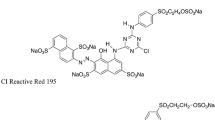Abstract
The study of functional and dyeing properties of the electrospun nanofibers has recently gained substantial interest. However, the dyeing of nanofibers still in transition phase and faces problem of lower color yield. Owing to the higher surface area of cellulose nanofibers, the color yield obtained is nearly four to five times lower than the conventional cotton fiber. The present work reports on dyeing of cellulose nanofibers with CI reactive black 5 dye via a simple and dual padding method to improve color yield and dye fixation. The color yields were determined by K/S values and color coordinates using spectrophotometer and the results were compered between single and dual padding methods. The dyed cellulose nanofibers were characterized by FTIR, WAXD and FE-SEM. X-ray diffraction studies revealed that the dyed cellulose nanofibers having Cellulose II form and show a better crystallinity than the undyed cellulose nanofibers.
Graphical abstract







Similar content being viewed by others
References
Bai G, Song XY (2005) Dyeing properties of polyamide super-microfibre with disperse dyes. Color Technol 121:329–331
Chung C, Lee M, Choe EK (2004) Characterization of cotton fabric scouring by FT-IR ATR spectroscopy. Carbohydr Polym 58:417–420
de Morais Teixeira E, Corrêa AC, Manzoli A, de Lima Leite F, de Oliveira CR, Mattoso LHC (2010) Cellulose nanofibers from white and naturally colored cotton fibers. Cellulose 17:595–606
Ding B, Li C, Hotta Y, Kim J, Kuwaki O, Shiratori S (2006) Conversion of an electrospun nanofibrous cellulose acetate mat from a super-hydrophilic to super-hydrophobic surface. Nanotechnol 17:4332–4339
Ford ENJ, Mendon SK, Thames SF, Rawlins JW (2010) X-ray diffraction of cotton treated with neutralized vegetable oil-based macromolecular crosslinkers. J Eng Fiber Fabr 5:10–20
Goswami P, Blackburn RS, Taylor J, White P (2009) Dyeing behaviour of lyocell fabric: effect of NaOH pre-treatment. Cellulose 16:481–489
Goswami P, Blackburn RS, Taylor J, White P (2011) Sorption of dyes on cellulose II: effect of alkali treatment of fibre and dye structure. Cellulose 18:1063–1072
Greiner A, Wendorff JH (2007) Electrospinning: a fascinating method for the preparation of ultrathin fibers. Angew Chem Int Edit 46:5670–5703
Han XJ, Huang ZM, He CL, Liu L, Wu QS (2008) Coaxial electrospinning of PC (shell)/PU (core) composite nanofibers for textile application. Polym Comp 29:579–584
Huang L, Nagapudi K, Apkarian RP, Chaikof EL (2001) Engineered collagen–PEO nanofibers and fabrics. J Biomater Sci-Polym E 12:979–993
Jonoobi M, Harun J, Mathew AP, Hussein MZB, Oksman K (2010) Preparation of cellulose nanofibers with hydrophobic surface characteristics. Cellulose 17:299–307
Jonoobi M, Khazaeian A, Tahir PM, Azry SS, Oksman K (2011) Characteristics of cellulose nanofibers isolated from rubberwood and empty fruit bunches of oil palm using chemo-mechanical process. Cellulose 18:1085–1095
Kang YK, Park CH, Kim J, Kang TJ (2007) Application of electrospun polyurethane web to breathable water-proof fabrics. Fibers Polym 8:564–570
Khatri Z, Wei K, Kim BS, Kim IS (2011a) Effect of deacetylation on wicking behavior of co-electrospun cellulose acetate/polyvinyl alcohol nanofibers blend. Carbohydr Polym 87:2183–2188
Khatri Z, Memon MH, Khatri A, Tanwari A (2011b) Cold Pad-Batch dyeing method for cotton fabric dyeing with reactive dyes using ultrasonic energy. Ultrason Sonochem 18:1301–1307
Khatri A, White M, Padhye R, Momin NH (2012a) The use of reflectance measurements in the determination of diffusion of reactive dyes into cellulosic fiber. Color Res Appl. doi:10.1002/col.21764
Khatri Z, Mayakrishnan G, Hirata Y, Wei K, Kim IS (2012b) Cationic-cellulose nanofibers: preparation and dyeability with anionic reactive dyes for apparel application. Carbohydr Polym 91:434–443
Khatri Z, Khatri A, Saleem U, Mayakrishnan G, Kim BS, Wei K, Kim IS (2012c) Pad dyeing of cellulose acetate nanofibres with disperse dyes. Color Technol. doi:10.1111/j.1478-4408.2012.00409.x
Kim BS, Kimura N, Kim HK, Watanabe K, Kim IS (2011) Thermal insulation, antibacterial and mold properties of breathable nanofiber-laminated wallpapers. J Nanosci Nanotechnol 11:4929–4933
Nishiyama Y, Langan P, Chanzy H (2002) Crystal structure and hydrogen-bonding system in cellulose Iβ from synchrotron X-ray and neutron fiber diffraction. J Am Chem Soc 24:9074–9082
Nishiyama Y, Sugiyama J, Chanzy H, Langan P (2003) Crystal structure and hydrogen bonding system in cellulose Ia from synchrotron X-ray and neutron fiber diffraction. J Am Chem Soc 125:14300–14306
Shore J (1995) Dyeing with reactive dyes. In: Shore J (ed) Cellulosic dyeing. Society of Dyers and Colourists, United Kingdom, pp 189–245
Sumin L, Kimura D, Yokoyama A, Lee K, Park JC, Kim IS (2009) The effects of laundering on the mechanical properties of mass-produced nanofiber web for use in wear. Text Res J 79:1085–1090
Sumin L, Kimura D, Lee KH, Park JC, Kim IS (2010) The effect of laundering on the thermal and water transfer properties of mass-produced laminated nanofiber web for use in wear. Text Res J 80:99–105
Tang S, Baker GA, Ravula S, Jones J, Zhao H (2012) Novel PEG-functionalized ionic liquids for cellulose dissolution and saccharification. Green Chem 14:2922–2932
Yoon B, Lee S (2011) Designing waterproof breathable materials based on electrospun nanofibers and assessing the performance characteristics. Fibers Polym 12:57–64
Acknowledgments
This work was supported by Grants for Excellent Graduate Schools, MEXT, Japan.
Author information
Authors and Affiliations
Corresponding authors
Rights and permissions
About this article
Cite this article
Khatri, Z., Arain, R.A., Jatoi, A.W. et al. Dyeing and characterization of cellulose nanofibers to improve color yields by dual padding method. Cellulose 20, 1469–1476 (2013). https://doi.org/10.1007/s10570-013-9893-7
Received:
Accepted:
Published:
Issue Date:
DOI: https://doi.org/10.1007/s10570-013-9893-7




